Sharp OZ-730, OZ-750 Owner's Manual

Declaration of Conformity
Electronic Organizer: OZ-730PC/OZ-750PC
This device complies with Part 15 of the FCC Rules.
Operation is subject to the following two conditions: (1) This device may not cause harmful interference, and (2) this device must accept any interference received, including interference that may cause undesired operation.
WARNING - FCC Regulations state that any unauthorized changes or modifications to this equipment not expressly approved by the manufacturer could void the user’s authority to operate this equipment.
Note: This equipment has been tested and found to comply with the limits for a Class B digital device, pursuant to Part 15 of the FCC Rules.
These limits are designed to provide reasonable protection against harmful interference in a residential installation. This equipment generates, uses, and can radiate radio frequency energy and, if not installed and used in accordance with the instructions, may cause harmful interference to radio communications.
However, there is no guarantee that interference will not occur in a particular installation. If this equipment does cause harmful interference to radio or television reception, which can be determined by turning the equipment off and on, the user is encouraged to try to correct the interference by one or more of the following measures:
-Reorient or relocate the receiving antenna.
-Increase the separation between the equipment and receiver.
-Connect the equipment into an outlet on a circuit different from that to which the receiver is connected.
-Consult the dealer or an experienced radio / TV technician for help.
Note: A shielded interface cable is required to ensure compliance with FCC regulations for Class B certification.
Responsible Party:
SHARP ELECTRONICS CORPORATION
Sharp Plaza, Mahwah, New Jersey 07430-2135
TEL: 630-378-3590
Tested To Comply With FCC Standards
FOR HOME OR OFFICE USE
FOR YOUR RECORDS....
For your assistance in reporting this Electronic Organizer in case of loss or theft, please record the model number and serial number (located on the bottom of the case) below.
Please retain this information
Model Number _______________________________
Serial Number _______________________________
Date of Purchase _____________________________
Place of Purchase ____________________________

Introduction
Congratulations on purchasing the OZ-730/OZ-750 Electronic Organizer.
Please read this operation manual thoroughly to familiarize yourself with all the features of the unit and to ensure years of reliable operation. You may also find it useful to keep this operation manual on hand for reference.
Some of the accessories described in this manual may not be available at the time you purchase this Organizer.
Check with your local SHARP dealer concerning availability.
All company and / or product names are trademarks and/or registered trademarks of their respective manufacturers.
Day-Timerâ and Day-Timer Organizerâ are registered trademarks of Day-Timers, Inc.
Windowsâ is a registered trademark of Microsoft Corporation.
Note:
*The differences between OZ-730/OZ-750 are memory capacity. Also, the OZ-750 Organizer has an optical communication terminal (IrDA), while OZ-730 does not. The remainder of the functions are common.
*Unless otherwise specified, the text and material in this manual applies to both models.
Introduction 1
*One of the models described in this manual may not be available in some countries.
*Some of the accessories described in the manual may be unavailable in some countries.
NOTICE:
*SHARP strongly recommends that you keep separate permanent written records of all important data. Data may be lost or altered in virtually any electronic memory Organizer under certain circumstances. Therefore, SHARP assumes no responsibility for data lost or otherwise rendered unusable whether as a result of improper use, repairs, defects, battery replacement, use after the specified battery life has expired, or any other cause.
*SHARP assumes no responsibility, directly or indirectly, for financial losses or claims from third persons resulting from the use of this Organizer and any of its functions, such as stolen credit card numbers, the loss or alteration of stored data, etc.
*The information provided in this manual is subject to change without notice.
The screen examples shown in this manual may not exactly match those of the product.
For example, although the field name is reversed on the product’s screen, the field name on the relevant screen in this manual may not be reversed.

2 Contents |
|
|
|
Contents |
|
Introduction |
.......................................................................... |
1 |
Contents ........................................................................... |
|
2-3 |
Caring for the ......................................................Organizer |
4 |
|
Chapter 1 ........................................ |
Getting Started |
5-12 |
Part Names and Functions |
|
|
Getting the Organizer Up and Running |
|
|
Setting up the Organizer after Initialization |
|
|
Getting to Know Your Organizer |
|
|
Chapter 2 ................................. |
General Operation |
13-22 |
Opening an Application - The First Main Menu |
|
|
Selecting the Display Modes |
|
|
Creating a New Entry |
|
|
Editing an Existing Entry |
|
|
Editing Techniques |
|
|
Finding Specific Entries in Your Organizer |
|
|
Deleting Entries |
|
|
Checking the Time and Date |
|
|
Checking the Memory |
|
|
The Second Main Menu - the Organizer’s Basic Utilities |
||
Chapter 3 |
Time Management................................. |
23-30 |
The Calendar Application |
|
|
The Schedule Application |
|
|
The To Do Application |
|
|
The Birthday / Ann (Anniversary) Application |
|
|
Chapter 4 |
Creating Your Own Database ............... |
31-32 |
The Tel Application |
|
|
Chapter 5 |
Memo ..................................................... |
33-34 |
The Memo Application |
|
|
Chapter 6 |
Desk Accessories .................................. |
35-42 |
The Calc (Calculator) Application |
|
|
The Clock Application |
|
|
Chapter 7 |
Expense ................................................. |
43-46 |
Entering Expense Record
Expense Report
Chapter 8 Features and Utilities for Added Power .. 47-50
Copying or Moving Blocks of Text Copying or Moving Entries Special Characters
Chapter 9 Data Transfer ......................................... 51-54
Transferring Data
Exchanging Information with a Personal Computer

Contents 3
Chapter 10 Personalizing Your Organizer ............... |
55-60 |
The Start-Up Display |
|
Setting the Owner’s Information |
|
Locking the Organizer |
|
Changing the Calendar Display Format |
|
Assigning Keys for short-cut entry |
|
Selecting the Large Font View |
|
Chapter 11 How to use the Add-on ......................... |
61-62 |
Installing My Programs application |
|
Setting a My Programs application to Autorun |
|
Appendices .................................................................. |
63-67 |
A. Resetting the Organizer |
|
All reset operation |
|
B. Battery Replacement |
|
General guidelines |
|
Replacing the operating batteries |
|
C. Specifications |
|
Index ............................................................................. |
68-71 |
Product Support ................................................................. |
72 |
Troubleshooting ................................................................. |
73 |
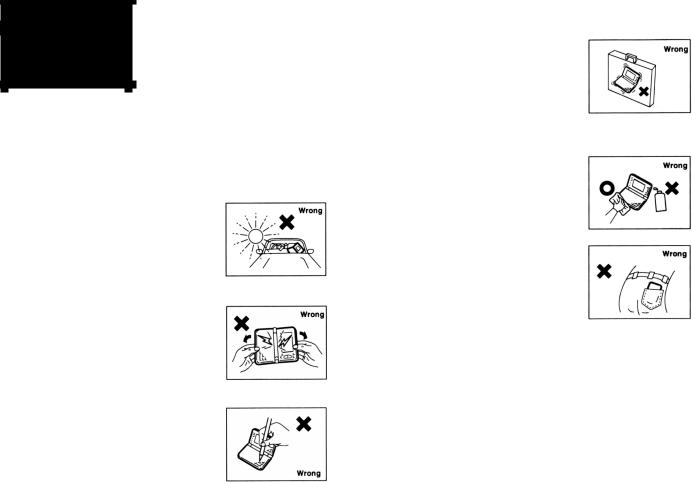
4Caring for the Product
Caring for the
Organizer
The Organizer contains sophisticated circuitry and a glass display panel which can be damaged if not handled with care. A few precautions should be taken regarding the Organizer’s care to ensure it gives you many years of reliable and trouble-free use.
*Keep the Organizer away from extreme heat. Do not leave it on the dashboard of a car or near any source of heat. Do not leave it in any place that is extremely damp or dusty.
*Do not drop the Organizer or subject it to severe impact or extreme force. Bending the Organizer unduly can damage it.
*Do not use extreme force when pressing the keys. Do not use any sharp, pointed object to press them.
*Sharp or hard object can scratch and damage the Organizer. Make sure it is adequately protected when carried with other objects. Do not carry it loose in a bag or briefcase: find a pocket or secure compartment within your bag.
*Clean the Organizer only with a soft, dry cloth. Do not use solvents.
*Do not carry the Organizer around in your back pocket, as it may break when you sit down. The display is made of glass and is very delicate.
*Since this Organizer is not waterproof, do not use it or store it where fluids, for example water, can splash onto it. Raindrops, water spray, juice, coffee, steam, perspiration, etc. will also cause malfunction.
*Replace the batteries as soon as they become weak (see p.64). Failing to replace weak batteries may result in leakage or lost data.
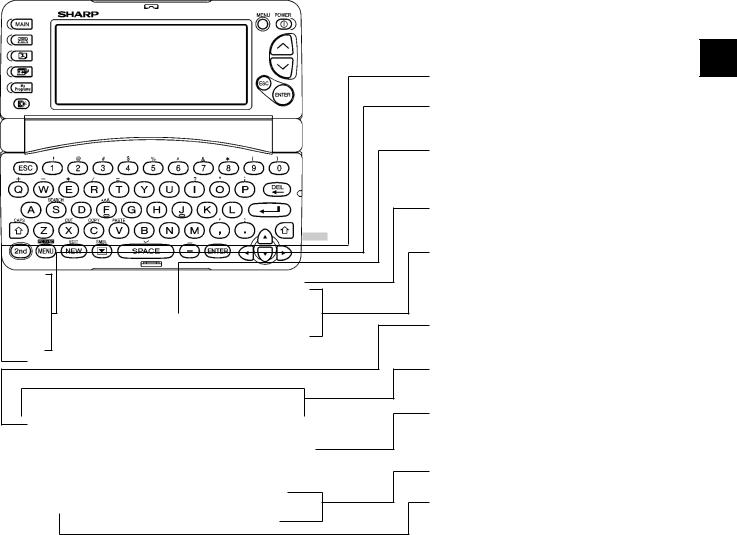
CHAPTER 1 Getting Started
This chapter explains everything you need to know to set up and begin working with your Organizer, from installing the batteries to initialization. The chapter also includes a labeled illustration of the parts of the Organizer, and basic explanation of its key features, from the keyboard to the display and its symbols.
Part Names and Functions
Getting Started |
5 |
1
Backlight key
Application keys
Starts appropriate applications
Display
Shows information, and is used for navigating the various function
Power key
Turns on and off the unit
Page scroll keys
Quick press/release move up or down one record at a time. Allows moving up or down one screen at a time if held down for a length of time.
ESC key
Cancels an operation
Keyboard
For entry of characters, numbers and commands
4-pin cable jack
Connects 4-pin Communication Cable for PC synchronization
Arrow keys
Menu key
Opens the Application Menu
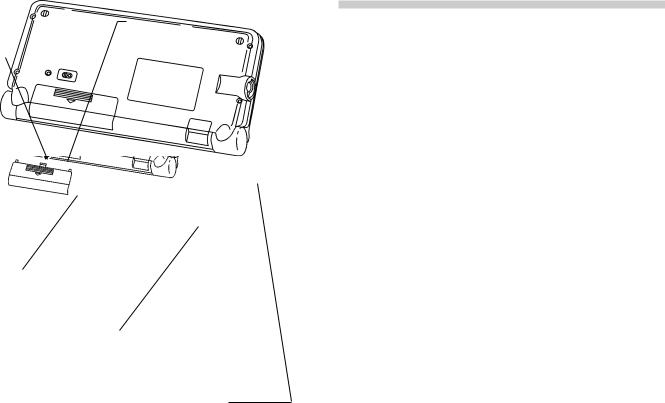
6 |
Getting Started |
|
Reset button |
Battery replacement switch |
|
|
Initializes and resets |
Locks the battery compartment |
|
the Organizer. |
to prevent access to the batteries. |
Getting the Organizer Up and Running
Installing the batteries
1.Set the battery replacement switch on the bottom of the Organizer to REPLACE BATTERIES (a red dot becomes visible).
2.Slide off the operating batteries cover.
Operating battery compartment
Holds operating batteries.
Infrared port (OZ-750 only)
For wireless communication with other OZ-750 Organizers.
4-pin Cable Jack
Connects 4-pin Communication Cable for PC synchronization.
3.Insert two batteries on top of the ribbon tab, making sure they are positioned correctly according to plus (+) and minus (-) polarity, as shown below.
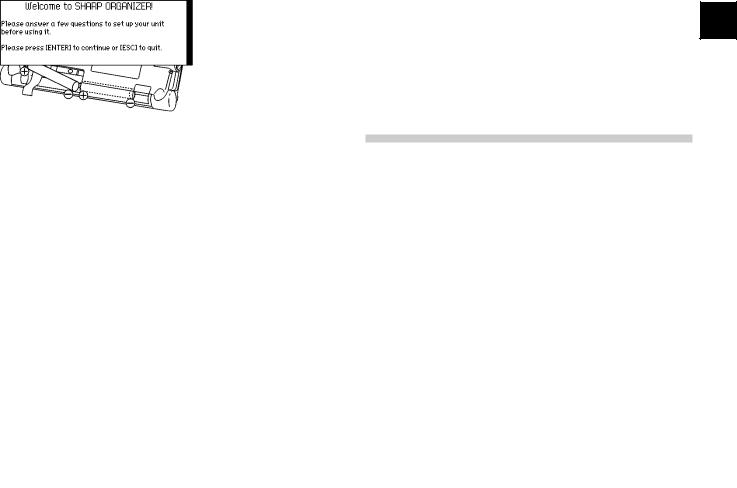
4.Replace the cover.
5.Set the battery replacement switch back to NORMAL OPERATION (the red dot disappears).
The Organizer will not function unless the battery replacement switch is in the NORMAL OPERATION position.
Initializing
The Organizer must be initialized when it is used for the first time.
1.Press and hold the  key.
key.
2.While holding down the  key, push the RESET button on the bottom of the Organizer using a pen or some other pointed object. The following message will appear.
key, push the RESET button on the bottom of the Organizer using a pen or some other pointed object. The following message will appear.
|
Getting Started |
7 |
||
3. Press to initialize the Organizer. |
|
|
|
|
1 |
||||
|
||||
The message “Working... Please wait.” appears while the Organizer proceeds with the initialization procedure.
The Welcome message then appears.
Setting up the Organizer after Initialization
The Organizer takes you through the various steps needed to set up the Organizer before use. These steps are described below. We strongly recommend that you complete the entire set up procedure before starting to actually use your Organizer.
*Welcome messages and instructions
*Setting the display contrast
*Setting the clock
Welcome messages and instructions
After pressing  to confirm initializing the unit, the Organizer displays the following welcome message, briefly outlining its functions.
to confirm initializing the unit, the Organizer displays the following welcome message, briefly outlining its functions.
Press  to proceed to the Basic Instruction screen. Press
to proceed to the Basic Instruction screen. Press  again to proceed with Display Contrast setup screen.
again to proceed with Display Contrast setup screen.
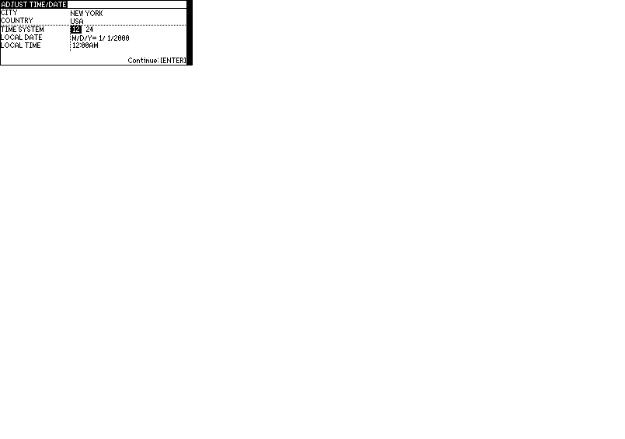
8Getting Started
Setting the Display Contrast
If the display is not clear, press  or
or  until the display is satisfactory.
until the display is satisfactory.
Press  to proceed with setting up the Clock as described below (or
to proceed with setting up the Clock as described below (or  to quit the set up procedure).
to quit the set up procedure).
Setting the City
In order to make sure that the Calendar, Schedule and other time-based applications work correctly, the built-in clock must be set to the correct time, date and city. When this Organizer is first initialized, the city is automatically set to New York. Before setting the Clock, you should first select the city for which you want to set the time.
After setting the Display Contrast, the following list of cities appears.
1.If the desired city does not appear, press 
 to display more cities.
to display more cities.
You can jump to a particular city by pressing the first letter of that country name.
2.Select the desired city by moving the cursor to it and then press  to confirm. Or select numbers
to confirm. Or select numbers  -
-  directly.
directly.
Press  to proceed with setting the Time and Date.
to proceed with setting the Time and Date.
Setting the Time and Date
After selecting the city, the ADJUST TIME / DATE screen appears.
1.Select the time system you want the clock to use by pressing  or
or  , then press
, then press  or
or  .
.
2.In the LOCAL DATE field, press  to display the pop-up calendar. Use
to display the pop-up calendar. Use  and
and  to select the current month, then use the arrow keys to select today’s date.
to select the current month, then use the arrow keys to select today’s date.
3.Press  once and the date has been selected. The popup calendar disappears and the date now appears in the LOCAL DATE field.
once and the date has been selected. The popup calendar disappears and the date now appears in the LOCAL DATE field.
4.Press  to move to LOCAL TIME field. Enter the local time, preceding single-digit hours and minutes with “0”. Press
to move to LOCAL TIME field. Enter the local time, preceding single-digit hours and minutes with “0”. Press  to select PM or
to select PM or  for AM.
for AM.
Press  to proceed to the Daylight Saving Time screen.
to proceed to the Daylight Saving Time screen.
5.If your city is currently on Daylight Saving Time, press  (Yes), otherwise press
(Yes), otherwise press  (No), then press
(No), then press  to confirm.
to confirm.
A new screen then appears to inform you that the basic setup
procedure is now completed, and the Organizer is ready for use. However, there are other areas in which you can customize your Organizer further by setting various options.
Setting the Start-up Display
You can control the way Organizer behaves each time you turn it on, including the background that appears. You can choose to activate the Autorun function before setting an autorun of My Program application once the Organizer is turned on.
1.Press  then press
then press  . Select AUTORUN in MY PROGRAMS MENU and press
. Select AUTORUN in MY PROGRAMS MENU and press  .
.
2.Use 

 and
and  to select application then press
to select application then press  .
.
Setting the World City
In addition to setting the local city, you can also select the world city, to display the time in another city of your choice alongside the Local time. When the Organizer is initialized, the world city is set to London.
To select the world city:
1.Press  twice to enter the Second Main Menu and select CLOCK then press
twice to enter the Second Main Menu and select CLOCK then press  .
.
2.Press  to open the Clock menu and select CHANGE WORLD CITY then press
to open the Clock menu and select CHANGE WORLD CITY then press  .
.
Getting Started |
9 |
|
The CHANGE WORLD CITY screen appears. A list of six capital |
|
|
|
1 |
|
cities is given, with five cities displayed at one time. |
|
|
|
|
|
3.If the city you wish to select does not appear in the list, type the first letter of the desired country.
4.Select the desired city by moving the cursor to it and then press  or select numbers
or select numbers  -
-  directly.
directly.
Setting the Password and Locking the Organizer
The Organizer allows you to keep selected entries in your Organizer secure by locking it with a password. Once the Organizer is locked, the Secret entries cannot be accessed until the Organizer is unlocked, for which the password must be given.
Select this option if you want to define a password and lock the Organizer.
1.Press  twice to enter the Second Main Menu.
twice to enter the Second Main Menu.
2.Select Secret then press  .
.
3.Select LOCK ORGANIZER then press  .
.
The Lock Organizer screen appears.
4.Enter the password you wish to use then press  .
.

10Getting Started
5.Re-type the password to confirm and then press  .
.
A message appears reminding you to remember your password or keep it in a safe place.
6.Press  .
.
The Second Main Menu appears.
Turning the Organizer on and off
Press  to turn the power on and press
to turn the power on and press  again to turn the power off. The Organizer will not operate if the battery replacement switch is in the REPLACE BATTERIES position.
again to turn the power off. The Organizer will not operate if the battery replacement switch is in the REPLACE BATTERIES position.
Auto power off
To conserve battery power, the Organizer will turn itself off if it has not been used for about 7 consecutive minutes. However, in order to avoid accidentally interrupting data transfers, the auto power-off function is disabled while communicating with other devices.
If the Organizer’s power goes off automatically before an entry you have been working with is stored in an application, the data will not be lost. When you press  , the Organizer will return to the same operating state as before the power turned off automatically.
, the Organizer will return to the same operating state as before the power turned off automatically.
Setting the LCD contrast
From time to time, the contrast of the LCD display may have to be adjusted for ideal readability. You may find, for example, that a contrast setting that was fine for the home or office is not
adequate when outdoors or when travelling on public tansport. Follow the procedure below adjust the LCD contrast.
1.Press  twice to enter the Second Main Menu.
twice to enter the Second Main Menu.
2.Select Contrast then press  .
.
3.Adjust the contrast by pressing  and
and  or
or  and
and  .
.
4.Press  when you are satisfied with the contrast.
when you are satisfied with the contrast.
Turning the key beep / alarm sound on and off
The Organizer can be set to make a sound (a beep) each time a key is pressed. This may help you to know whether a key has been pressed properly. The default setting is on. You can use the Second Main Menu to change the setting.
1.Press  twice to enter the Second Main Menu.
twice to enter the Second Main Menu.
2.Select Sound then press  .
.
3.Press  /
/  to choose ON or OFF in KEY SOUND / SCHEDULE ALARM/ DAILY ALARM.
to choose ON or OFF in KEY SOUND / SCHEDULE ALARM/ DAILY ALARM.
4.Press  /
/  to move between different options.
to move between different options.
5.Press  .
.
Backlight
The organizer provides a built-in Backlight, which allows you to view the display and use the organizer even in low-light conditions, eg. in a theater, restaurant, or business
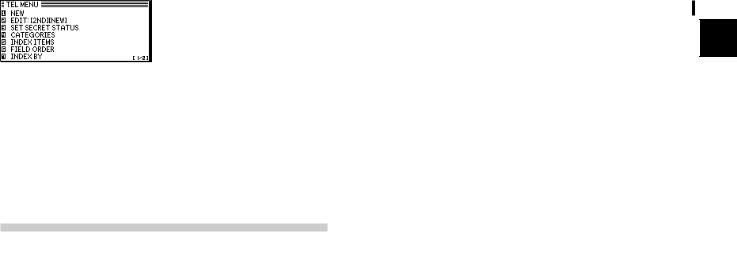
presentation. Pressing  once illuminates the display for as long as you continue to use the organizer, until you have not typed any key for about 1 minute or press
once illuminates the display for as long as you continue to use the organizer, until you have not typed any key for about 1 minute or press  again.
again.
Note: Do not use the backlight unnecessarily.
Since the backlight drains power from the operating batteries, excessive use of the backlight will significantly reduce your battery life.
Continuous use of the backlight will, over time, lead to gradual loss of brightness.
Getting to Know Your Organizer
OZ-730/OZ-750 is a compact yet sophisticated information management device that you can use anytime. Its applications and utilities allow you to enter and organize information, and it has powerful communications facilities that enable you to put that information to optimum use when you return to your home or office. You can quickly update your computerized mailing lists, for example, or even transfer your notes, letters and memos onto a PC for further processing.
Applications
Operations on the Organizer are performed using applications. The Organizer’s Calendar and Schedule, for example, are applications that record and display time related information. To start an application, select the application in the Main Menus or press the Application keys on the left of the screen (Main /
Tel / Schedule / Memo / My Programs).
Getting Started 11
When working in one application, you can switch to another application simply by pressing that application key (Main / Tel 1
/ Schedule / Memo / My Programs only). Data being processed in the first application will be kept, even if the entry is not complete.
Menu operations
Another powerful aspect of using the Organizer is its menu system, which can be used to quickly issue commands and perform operations. Press  once displays the application menu, which contains the operations and commands specific to the particular application.
once displays the application menu, which contains the operations and commands specific to the particular application.
Pop-up menus
The Organizer’s pop-up menus offer a convenient and efficient method of selecting options from pre-defined lists, similar to many of the latest personal computer application software packages. Most applications and functions contain some popup fields. When the user moves to one of these fields, the popup symbol appears on the right of the field. Pressing  causes the pop-up menu to appear, containing a list of options or values currently available for that field. You can then select the desired item from the list without having to type any text.
causes the pop-up menu to appear, containing a list of options or values currently available for that field. You can then select the desired item from the list without having to type any text.
In addition, all date fields function as pop-up fields. Where a date can be entered, the user can press  to display the
to display the
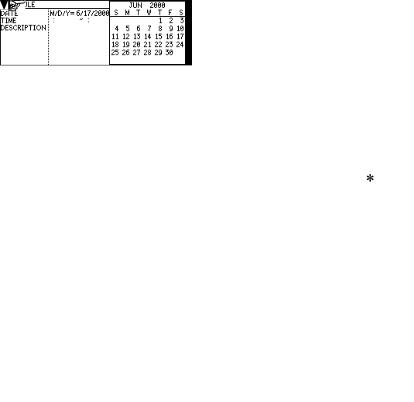
12 Getting Started
special pop-up one-month calendar. You can use  and
and  to select the desired month, then the arrow keys to select the desired date. You may find this more convenient than typing in the date directly, since the pop-up calendar also shows the days of the week.
to select the desired month, then the arrow keys to select the desired date. You may find this more convenient than typing in the date directly, since the pop-up calendar also shows the days of the week.
The keyboard
The Organizer’s keyboard has a standard layout, just like a typewriter or computer.  works just like the Shift key on a typewriter or computer, and
works just like the Shift key on a typewriter or computer, and 
 is like the Caps Lock key.
is like the Caps Lock key.
Symbols in Dark blue above a key such as ’ or : can be accessed by holding down  and then pressing the appropriate key.
and then pressing the appropriate key.
Functions in violet above a key, such as SEARCH, can be accessed by pressing the particular key after pressing  . There is no need to hold down
. There is no need to hold down  while you press the desired key.
while you press the desired key.
Special symbols and characters, such as “?” and “/”, can also be entered by using 
 . For a full explanation, see P.48.
. For a full explanation, see P.48.
Display Symbols
The following symbols appear at the top right hand corner of the screen to indicate various operating conditions.

 has been pressed. In caps lock mode, all typed letters will be in upper case. Press
has been pressed. In caps lock mode, all typed letters will be in upper case. Press 
 again to turn off the caps lock.
again to turn off the caps lock.
The  key has been pressed
key has been pressed
The current entry (in View or Edit mode) has been marked as Secret.
The Organizer is locked. Entries marked as secret cannot be accessed without first entering the password and unlocking the Organizer. (see p.56)
These symbols indicate that all information in an entry cannot be shown simultaneously on the display. The additional entries or fields which cannot fit onto the display can be viewed by pressing the displayed arrow keys.

CHAPTER 2 General Operation
This chapter introduces most of the Organizer’s basic operations. The Tel application will be used for the examples. However, most of the techniques described here can be applied to all of the Organizer’s applications.
Opening an Application - The First Main
Menu
To start an application, press  to enter the Main Menu to select the application or simply press the application key located on the left of the display. Press
to enter the Main Menu to select the application or simply press the application key located on the left of the display. Press  /
/  /
/  /
/ 
 , the selected application will appear. Any application already being displayed will be hidden whenever a new application is selected. You can always return to another application at the exact point where you left off simply by pressing its key again. However, only one application can be displayed at a time.
, the selected application will appear. Any application already being displayed will be hidden whenever a new application is selected. You can always return to another application at the exact point where you left off simply by pressing its key again. However, only one application can be displayed at a time.
Main Menu
|
|
General Operation |
13 |
|
Selecting the Display Modes |
|
|
||
Once an application is open, you can switch between three |
|
|
||
|
2 |
|||
basic display modes: Index, View and Edit. Each display mode |
|
|||
has its own unique appearance and particular purpose. Index |
|
|
||
|
|
|||
mode is normally the default view when an application is |
|
|
||
opened, and provides a summary of the individual entries that |
|
|
||
have been created. Pressing after selecting a particular |
|
|
||
entry causes the entry to be displayed in View mode, which |
|
|
||
shows the full details of the entry. During View mode, no entry |
|
|
||
details may be altered. |
|
|
|
|
Pressing |
either when an entry is displayed in View |
|
|
|
mode or is selected in Index Mode, causes the entry to be |
|
|
||
displayed in Edit mode. The entry’s details can then be altered |
|
|
||
as desired. Edit mode is also used when a new entry is being |
|
|
||
created (by pressing |
). |
|
|
|
Index mode
The Index mode shows you a list view of the entry within the application. This allows you to easily find a particular entry, which you can then display in full (View mode) by pressing
 .
.
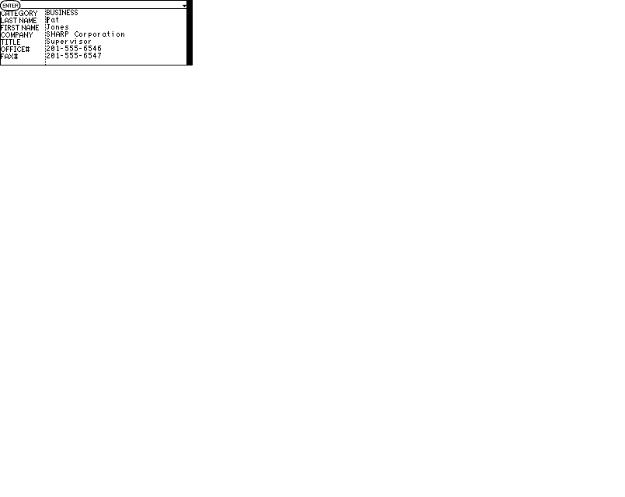
14 General Operation
Other operations:
Creates a new entry for the current application (in Edit mode).
Displays the currently selected entry and edits it (Edit mode).
Deletes the currently selected entry.
Displays any previous/subsequent entries not shown.
Selects an entry
Displays category menu and user can select a category
View mode
View mode allows you to see the full details of an entry, without being able to edit or change it.
Other operations:
Creates a new entry for the current application (in Edit mode).
Edits the currently displayed entry.
Deletes the currently selected entry.
Displays any previous/subsequent entries not shown.
Displays any information not shown within an entry.
Switches to Index mode.
Edit mode
Edit mode is used to create a new entry or edit an existing entry.
Other operations:
When you cancel your changes to the data in edit mode, “Do you really want to throw away all of these changes? Yes: [ENTER] / No: [ESC]” will be shown for confirmation.
Stores an entry in the Organizer’s memory or initiates an operation.
Stores an edited entry as new and leaves the original entry unchanged.

Activities the pop-up menu for a field displaying the “pop-up” symbol.
Moves the cursor.
Displays any information not shown within an entry.
Creating a New Entry
In Index or View mode, pressing  opens a blank form for creating a new entry.
opens a blank form for creating a new entry.
Make the following new Tel entry:
CATEGORY |
PERSONAL |
LAST NAME |
Jones |
FIRST NAME |
Pat |
OFFICE# |
201-555-6546 |
FAX# |
201-555-6547 |
COMPANY |
SHARP Corporation |
TITLE |
Supervisor |
1.Press  to open the application.
to open the application.
2.Press  on the keyboard.
on the keyboard.
A blank form opens in Edit mode.
General Operation 15
2
3.Press  to move to the CATEGORY field . Press
to move to the CATEGORY field . Press  to open the pop-up menu. Select PERSONAL.
to open the pop-up menu. Select PERSONAL.
4.Press  to move to the LAST NAME field and type in
to move to the LAST NAME field and type in
Jones.
5.Press  to move to the FIRST NAME field and type in
to move to the FIRST NAME field and type in
Pat.
6.Press  to move to the OFFICE# field and type in 201- 555-6546.
to move to the OFFICE# field and type in 201- 555-6546.
7.Press  to move to the FAX# field and type in 201-555- 6547.
to move to the FAX# field and type in 201-555- 6547.
8.Press  to move to the COMPANY field and type in SHARP Corporation.
to move to the COMPANY field and type in SHARP Corporation.
9.Press  to move to the TITLE field and type in Supervisor.
to move to the TITLE field and type in Supervisor.
10.Press  to store the entry.
to store the entry.
The message “Stored!” appears briefly. The entry is now stored in the Organizer’s memory and displayed in View mode.

16 General Operation
For other useful methods available in Edit mode, see right.
Editing an Existing Entry
To edit an entry already stored in memory, you must first access the entry in Edit mode (in which it was originally created).
1.Press  to open the application.
to open the application.
2.Select the desired entry in Index mode.
3.Press 
 to open the entry in Edit mode.
to open the entry in Edit mode.
4.Make any necessary changes.
5.Press  to store the changes when you are finished. The new, edited entry is now stored, replacing the original entry.
to store the changes when you are finished. The new, edited entry is now stored, replacing the original entry.
Editing Techniques
This section explains all the general editing techniques used in Edit mode when making a new entry or editing an existing entry in all of the applications. (The Memo application has many additional features for working with text; see p.33 for more information.)
Fields
Most applications divide the display into field boxes. The number of fields in each application varies, as do the types of fields. The different types of field include text fields, a date field, time fields and pop-up fields.
You can type any character into a text field. The size of a text field is limited only by the size of the entry. Text fields adjust their size automatically to accommodate the number of lines entered.
Only a date can be entered in a date field, usually in the format MM/DD/YYYY For example, you would type 07232000 to enter July 23, 2000.
Only a time of day can be entered in the time field, in the format of HH:MM followed by  or
or  (for AM and PM). For example, to enter 9:00 AM, you would type 0900 then press
(for AM and PM). For example, to enter 9:00 AM, you would type 0900 then press  .
.
When the pop-up symbol  appears by a field while editing an entry, this indicates that a pop-up menu is available for the field. The pop-up menu contains a list of values available for the field, and is used by pressing
appears by a field while editing an entry, this indicates that a pop-up menu is available for the field. The pop-up menu contains a list of values available for the field, and is used by pressing  and selecting the desired value from the pop-up list. Note that the pop-up symbol only
and selecting the desired value from the pop-up list. Note that the pop-up symbol only

appears next to a field in Edit mode, when the field is selected. When you move out of a pop-up field, the pop-up symbol disappears.
The cursor
The cursor is used to work with text, indicating the position where text will be entered or deleted. It is also used to select items from menus or lists.
In text fields, where there is no restriction on the type of text (letters or numbers) that can be entered, the cursor appears as |.
In the date and time fields, the cursor appears as  , indicating that numbers only should be entered in a specified format (see above).
, indicating that numbers only should be entered in a specified format (see above).
In text fields or boxes when there is no character at the cursor position, the cursor appears as |.
Typing in text
Typing in text is simple and straightforward. The Organizer’s keyboard layout is just like the keyboard on a typewriter or computer.
Letters (lower-case and upper-case)
Any of the standard letters (A to Z) can be entered by pressing the corresponding key. All letters will normally appear in lower case. Hold down either of the  keys while pressing letter key
keys while pressing letter key
(s) to enter upper-case letters. 
 functions like a “Caps lock” key on a typewriter or computer. Once pressed, the symbol
functions like a “Caps lock” key on a typewriter or computer. Once pressed, the symbol  will appear at the upper right corner of the display.
will appear at the upper right corner of the display.
|
General Operation |
17 |
||
Any letters typed while the Organizer is in CAPS mode will |
|
|
||
appear in upper case. To switch back to lower-case mode, |
|
|
||
simply press |
again. To enter lower-case letters while in |
|
|
|
2 |
||||
CAPS mode, hold down while pressing a letter key. |
||||
|
|
|||
Numbers
Pressing the corresponding numeric keys enters numbers. Numbers are entered regardless of whether CAPS mode is on or off.
Symbols
The symbols that appear in dark blue above certain keys can be entered directly from the keyboard. Holding down  while pressing the appropriate key will allow you to enter these symbols. Colons can be entered by holding down
while pressing the appropriate key will allow you to enter these symbols. Colons can be entered by holding down  and pressing the
and pressing the  key. In addition, a large number of special symbols are available by pressing
key. In addition, a large number of special symbols are available by pressing 
 . (see p.48)
. (see p.48)
Moving around the Display
You can move the cursor around the display with the arrow keys 


 ,
, 
 . In addition, you can hold any arrow key down for continuous rapid movement.
. In addition, you can hold any arrow key down for continuous rapid movement.
The following convenient keyboard shortcuts are also available in Edit mode:
Moves the cursor to the end of the line.
Moves the cursor to the beginning of the line.
Moves the cursor to the first line of a field.
Moves the cursor to the last line of a field.
Moves the cursor to the first field.
Moves the cursor to the last field.
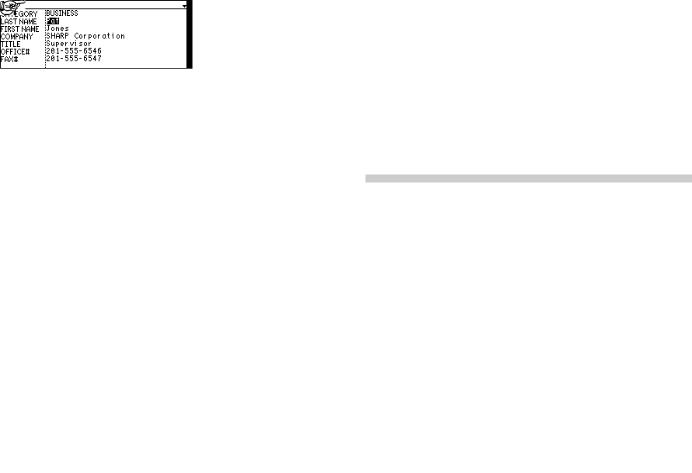
18 General Operation
Deleting Text
If you make a mistake while entering text, use the following key to erase the incorrect text, then enter the correct text:
Deletes the character before the cursor.
Working with Blocks of Text
Working with a block of text is sometimes easier and more convenient than working with characters one by one. The first step is to select the text to work with.
1.Hold down the  key while using the arrow keys to move over the entire text that you want to work with. This will “highlight” the text (display it in reverse white on black).
key while using the arrow keys to move over the entire text that you want to work with. This will “highlight” the text (display it in reverse white on black).
2.You can now perform a number of operations on the selected text.
Deletes the selected text
Copies the selected text to the clipboard so that it can later be pasted to another location. Deletes the selected text from its current location and moves it to the clipboard.
Replaces the selected text with whatever is currently in the clipboard.
For a full explanation of the cut / copy / paste functions, see p.47.
Scrolling the Display
If there is more information than can be displayed at one time,  or
or  will appear at the top right hand corner of the screen.
will appear at the top right hand corner of the screen.
Press  or
or  to scroll the information one line at a time.
to scroll the information one line at a time.
Finding Specific Entries in Your Organizer
There are a number of ways that you can locate entries and information in your Organizer. One is to scroll between entries using the  or
or  keys. Others are as follows.
keys. Others are as follows.
Using Index Mode
Index mode gives you a listing of all the entries in a particular application. It is useful for providing a summary list of the entries contained for that application, from which a desired entry may be selected.
1.Press  to enter the Main Menu Screen to select the application or press the desired application key directly.
to enter the Main Menu Screen to select the application or press the desired application key directly.
2.If it is not already displayed, switch to Index mode by pressing  .
.
A list of the existing entries appears.
3.If the desired entry is not displayed, you can scroll the list of entries by pressing  or
or  .
.
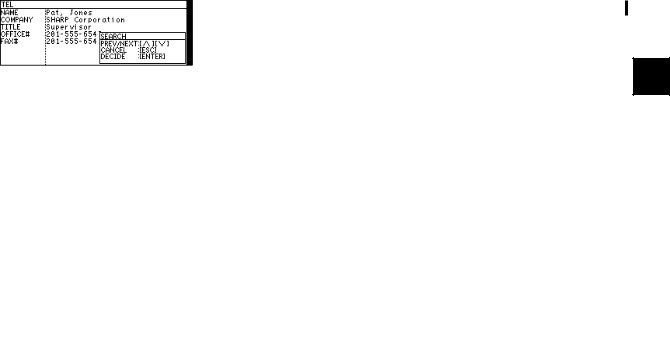
4.When the desired entry is displayed, select it and press  to see the entry in full.
to see the entry in full.
5.The most relevant entry will be highlighted if you press any letters / symbols / numbers. Press  to see the details of the entry. (Only available in Tel / Memo application).
to see the details of the entry. (Only available in Tel / Memo application).
6.You can choose how items are arranged in an index by changing the index mode in INDEX ITEMS / INDEX BY within the application menu. (Only available in Tel / To Do / Memo applications).
Using Keywords
If you know a particular entry is in your organizer, but you cannot remember where, you can use the Search command to find it.
1.Press  to enter the Main Menu Screen to select the application or press the desired application key directly.
to enter the Main Menu Screen to select the application or press the desired application key directly.
2.Press  and then press
and then press  .
.
The Search window will open.
General Operation 19
2
3.Enter the name you are looking for. For example, type
Pat.
4.Press  or
or  and select Tel and press
and select Tel and press  to start searching.
to start searching.
To search only secret entries (see p.58), press 
 to check the SECRET ONLY item.
to check the SECRET ONLY item.
The Organizer will now display the first entry that contains the “keyword” that you entered.
If there is more than one entry that contains the keyword, press  until you find the entry you are looking for. Then press
until you find the entry you are looking for. Then press 
when you have finished searching.
By Date
You can use the Calendar to quickly and easily find information related to a time and / or date.
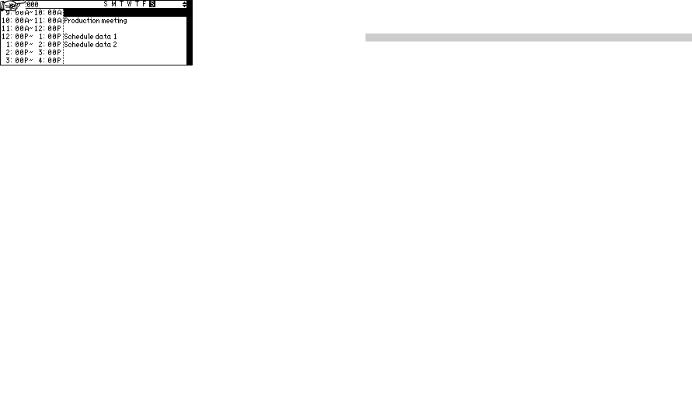
20General Operation
1.Press  to enter the Main Menu and select CALENDAR.
to enter the Main Menu and select CALENDAR.
The Calendar of the current month appears. (If there is a dot besides a specific day, it indicates that there is a Schedule appointment; if a specific date is displayed in reverse, it means that there is a Birthday / ANN entry.)
2.Select a day using the arrow keys, then press  to view the Schedule, Birthday / Ann or To Do entries on the selected day.
to view the Schedule, Birthday / Ann or To Do entries on the selected day.
For more information about using the Calendar application, see p.23.
You can open the Calendar menu by pressing  to select the desired Calendar view.
to select the desired Calendar view.
Deleting Entries
Entries in the Organizer can be deleted using either the  key or the application menu.
key or the application menu.
Deleting single entries
1.Open the desired application.
2.Select the entry in Index mode or view mode.
3.Press  on the keyboard.
on the keyboard.
A confirmation message appears asking if you are sure you want to delete the selected entry.
4.Press  (or
(or  to cancel the deletion).
to cancel the deletion).
Deleting entries using the application menu
You can also make deletions using the application menu. The DATA DELETION submenu allows you to do this flexibly and easily.
1.Open the desired application.
2.Select the entry in Index mode or display it in View mode.
3.Press  in the selected function to open the application menu.
in the selected function to open the application menu.
4.Select DATA DELETION, then press  .
.

Deletes a selected entry. Deletes all entries in the selected category
 Deletes all entries in all TEL files
Deletes all entries in all TEL files
5.Select SELECTED ENTRY, then press  .
.
A warning message appears asking if you are sure you want to delete the entry.
6.Press  (or
(or  to cancel the deletion).
to cancel the deletion).
Checking the Time and Date
The current time and date are shown on the top of the Main Screen. Press  to jump to the Main Menu screen directly.
to jump to the Main Menu screen directly.
1.Press  twice to enter the Second Main Menu and select Clock to check the current date and time.
twice to enter the Second Main Menu and select Clock to check the current date and time.
2.Press  or any other application key to close the Clock application.
or any other application key to close the Clock application.
For a full explanation of the Clock application, see p.38.
General Operation |
21 |
|
Checking the Memory |
|
|
The Organizer has a certain memory capacity in which |
|
|
|
2 |
|
operations are carried out and data that has been entered, |
|
|
such as phone numbers and memos, are stored. When the |
|
|
|
|
|
amount of data already stored approaches the Organizer’s |
|
|
maximum memory capacity, you may not be able to store an |
|
|
entry or the data being processed may be lost when you |
|
|
change applications. To avoid these problems, you should |
|
|
check the remaining memory space regularly and free up space |
|
|
when necessary by deleting out-of-date entries. The Check |
|
|
Memory function allows you to easily check the amount of free |
|
|
memory available in the Organizer, and thus avoid the |
|
|
inconvenience of running out of memory and losing data. |
|
|
1.Press  twice to enter the Second Main Menu.
twice to enter the Second Main Menu.
2.Select Memory then press  .
.
The display shows the summary of the Organizer’s memory usage, availability and version number.
3.Press  to close the display.
to close the display.
Even if the display shows a small amount of free memory available, that amount may be insufficient for certain
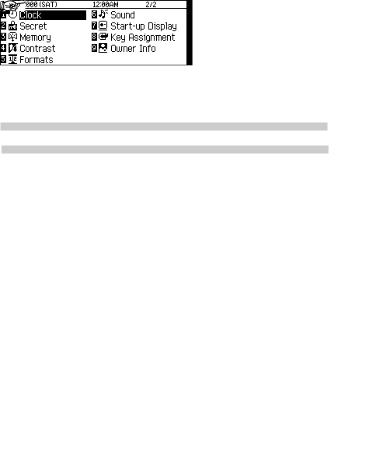
22 General Operation
operations to work properly. You are strongly recommended to carry out regular “housekeeping” by deleting unwanted or out-of-date information to prevent the memory becoming full.
The Second Main Menu - the Organizer’s
Basic Utilities
Many of the basic utilities are accessed through the Second Main Menu. It is also used to set up and configure certain features, such as the display contrast.
Press  twice to enter the Second Main Menu then press the number key to enter the respective application or move the cursor to select the application and press
twice to enter the Second Main Menu then press the number key to enter the respective application or move the cursor to select the application and press  .
.
ClockThe unit’s built-in clock displays the correct time and date in your area.
SecretSetting the password / locking the organizer (see p.56)
MemoryChecking the memory size (see p.21)
ContrastSetting the display contrast (see p.10)
FormatsSetting the calendar display format and time system (see p.59)
SoundSetting the key sound / daily alarm / schedule alarm on or off (see p.10)
Start-up displayActivating the autorun of basic application or choosing to show / hide the owner’s information (see p.55)
Key Assignment (see p.60)
Setting the Owner’s Information
The Owner Information comprises your name, address and telephone number. You can choose to have this information displayed each time you turn the Organizer on.
If you make a mistake while entering the Owner Information, don’t worry! You can edit the Owner Information easily during normal use.
1.Press  twice to enter the Second Main Menu and select Start-up Display then press
twice to enter the Second Main Menu and select Start-up Display then press  .
.
2.Press  to move to the OWNER INFORMATION field. Press
to move to the OWNER INFORMATION field. Press  /
/  to choose SHOW or HIDE the owner’s information.
to choose SHOW or HIDE the owner’s information.
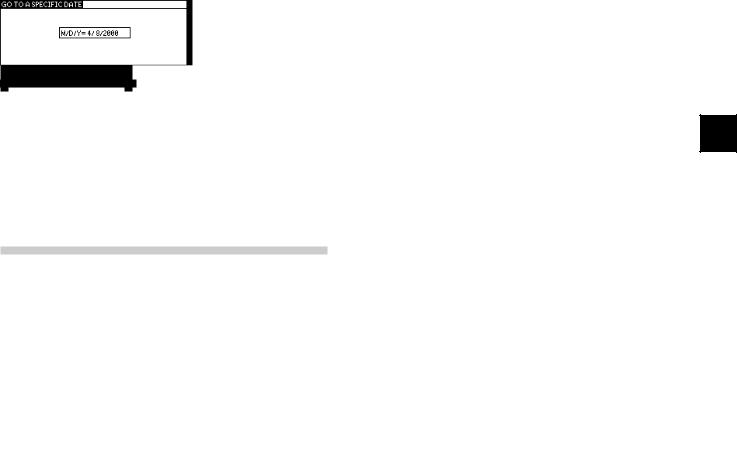
CHAPTER 3 Time Management
The Organizer’s Calendar, Schedule, To Do and Birthday / Ann (Anniversary) applications let you structure and manage your time easily, whether scheduling appointments or giving reminders about important people and events. The explanations and examples in this chapter will give you the information you need to make all of the time management features of these applications work for you on a daily basis.
The Calendar Application
The Calendar represents the Organizer’s most central utility. It serves as a calendar that you can reference at any time for the correct date, and also as a time management utility, indicating important dates so that you can keep track of your time and appointments. The application performs as a highly sophisticated calendar that can display details of any month from January 1901 to December 2099. The Calendar also provides you with a convenient way of accessing, viewing and making new entries in the Ann and Schedule applications.
The Calendar provides you several Calendar views: 3-Month View and Daily Calendar.
3-Month Calendar: The specified month is centered, and the previous and the next months are shown on the left and the right, respectively.
|
Time Management |
23 |
Daily Calendar: |
The specified day is shown. |
|
You can use the Calendar menu to select a particular Calendar view directly, regardless of which view you are already using.
1.Press  to open the Calendar menu.
to open the Calendar menu.
3
2.Select VIEW and press  .
.
3.Select the desired view in the submenu and press  .
.
Selecting a date
From any view, you can scroll to the previous or next time period (whether the next month or day) by pressing  or
or  , then moving the cursor to a specific date to select it for display in another Calendar view. However, another convenient way of selecting a date that is not on the display is using GO TO A SPECIFIC DATE in the Calendar application menu.
, then moving the cursor to a specific date to select it for display in another Calendar view. However, another convenient way of selecting a date that is not on the display is using GO TO A SPECIFIC DATE in the Calendar application menu.
1.Press  in any Calendar view, and select GO TO A SPECIFIC DATE, then press
in any Calendar view, and select GO TO A SPECIFIC DATE, then press  .
.
A date entry window appears.
2.Enter the date you want to select in the order of month, day, and year. Single-digit months and days should be preceded by a “0”.
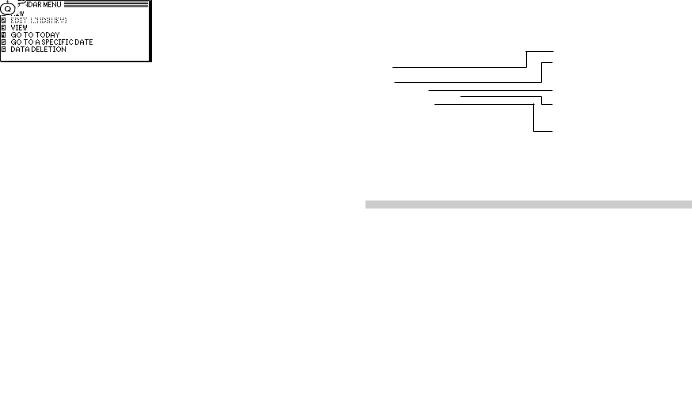
24Time Management
3.Press  .
.
The selected date will appear in the current Calendar view.
You can select GO TO TODAY in Calendar menu to directly skip to today.
You can select DAILY in VIEW menu to jump to today’s Daily calendar.
Date Calculating
You can find and display any date a given number of days before or after a particular date.
Example: View the calendar 60 days from today.
1.Enter into the 3-Month view.
2.Select GO TO TODAY in Calendar menu to skip directly to today.
3. Press |
to specify the date 60 days in the |
future. The calendar for the corresponding month |
|
appears, with the appropriate date selected. |
|
Press |
to specify a number of days in the past, |
for a number of days in the future.
The Calendar application menu
Creates a new entry (p.15) Selects the Calendar view (see p.23)
Goes to today Goes directly to a particular
date (see p.23)
Selects the specific entries for deletion (see p.20)
The Schedule Application
The Schedule application allows you to enter appointments, times and dates for meetings, parties and events, and also to set an alarm to sound prior to or at the time of a scheduled entry. This makes it easy to organize your entire day and manage your appointments. Schedule entries are indicated on the Calendar’s 3-Monthly view and Daily Calendar view.
Selecting a specific date
If you want to jump to a specific date to find entries or make a new entry, you can do it easily using the application menu.
1.In Index mode of the Schedule application, press  , and select GO TO A SPECIFIC DATE, then press
, and select GO TO A SPECIFIC DATE, then press  .
.
A date entry window appears.
